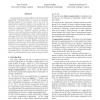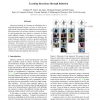139
click to vote
CVPR
2011
IEEE
14 years 8 months ago
2011
IEEE
We propose to bridge the gap between Random Field (RF) formulations for joint categorization and segmentation (JCaS), which model local interactions among pixels and superpixels, ...
102
click to vote
CVPR
2011
IEEE
14 years 8 months ago
2011
IEEE
Current face image retrieval methods achieve impressive results, but lack efficient ways to refine the search, particularly for geometric face attributes. Users cannot easily �...
107
click to vote
CVPR
2011
IEEE
14 years 8 months ago
2011
IEEE
In this paper, we design a novel MRF framework which is called Non-Local Range Markov Random Field (NLRMRF). The local spatial range of clique in traditional MRF is extended to th...
109
click to vote
CVPR
2011
IEEE
14 years 8 months ago
2011
IEEE
Objects vary in their visual complexity, yet existing discovery methods perform “batch” clustering, paying equal attention to all instances simultaneously—regardless of the ...
120
click to vote
CVPR
2011
IEEE
14 years 8 months ago
2011
IEEE
The goal of object category discovery is to automatically identify groups of image regions which belong to some new, previously unseen category. This task is typically performed i...
109
click to vote
CVPR
2011
IEEE
14 years 8 months ago
2011
IEEE
Cosegmentation is typically defined as the task of jointly segmenting “something similar” in a given set of images. Existing methods are too generic and so far have not demon...
100
Voted
CVPR
2011
IEEE
14 years 8 months ago
2011
IEEE
Supervised methods for learning an embedding aim to map high-dimensional images to a space in which perceptually similar observations have high measurable similarity. Most approac...
119
Voted
CVPR
2011
IEEE
14 years 8 months ago
2011
IEEE
We describe a generative model of the relationship between two images. The model is defined as a factored threeway Boltzmann machine, in which hidden variables collaborate to de�...
153
click to vote
CVPR
2011
IEEE
14 years 8 months ago
2011
IEEE
We describe an imaging architecture for compressive video sensing termed programmable pixel compressive camera (P2C2). P2C2 allows us to capture fast phenomena at frame rates high...
110
click to vote
CVPR
2011
IEEE
14 years 8 months ago
2011
IEEE
Visual attributes expose human-defined semantics to object recognition models, but existing work largely restricts their influence to mid-level cues during classifier training....


